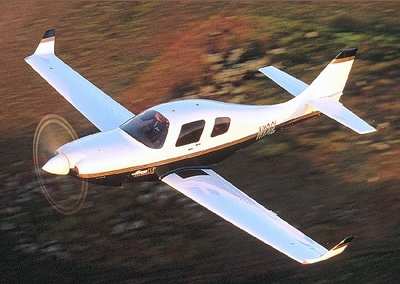Sun, Aug 12, 2007
 An August 1st accident
that downed a Lancair IV appears to have been caused by an
improperly secured oil line. The accident resulted in serious
injuries to the pilot, the sole person onboard.
An August 1st accident
that downed a Lancair IV appears to have been caused by an
improperly secured oil line. The accident resulted in serious
injuries to the pilot, the sole person onboard.
NTSB Prelim
NTSB Identification: DEN07LA133
14 CFR Part 91: General Aviation
Accident occurred Wednesday, August 01, 2007 in Sylvan Grove,
KS
Aircraft: Walker Lancair IV, registration: N7441W
Injuries: 1 Serious.
This is preliminary information, subject to change, and may
contain errors. Any errors in this report will be corrected when
the final report has been completed.
On August 1, 2007, approximately 1615 central daylight time,
a Walker Lancair IV (file photo of Lancair IV, shown below),
N7441W, piloted by an airline transport-certificated pilot, was
destroyed when it collided with terrain following a loss 3 miles
southeast of Sylvan Grove, Kansas. Visual meteorological conditions
prevailed at the time of the accident. The personal flight was
being conducted under the provisions of Title 14 CFR Part 91
without a flight plan. The pilot was seriously injured. The
cross-country flight originated at Junction City (3JC), Kansas, and
was en route to Santa Barbara, California (SBA).
FAA inspectors who examined the airplane at the accident
site reported finding evidence of catastrophic engine failure due
to oil starvation induced by an unsecured oil line to the wastegate
actuator.

Previously; N7441W was involved in a 2003 landing accident in
which the aircraft impacted a "runway while performing an S-turn
maneuver while landing. The pilot reported he was following another
airplane on final approach to runway 17 and had to perform S-turns
to increase spacing. He noted that runway 17 was narrower than he
was accustomed to, and the perceived aircraft altitude was higher
than it actually was. The pilot reported there was no mechanical
malfunction or failure." In that accident, the NTSB found that the
probable cause appeared to be "runway while performing an S-turn
maneuver while landing. The pilot reported he was following another
airplane on final approach to runway 17 and had to perform S-turns
to increase spacing. He noted that runway 17 was narrower than he
was accustomed to, and the perceived aircraft altitude was higher
than it actually was. The pilot reported there was no mechanical
malfunction or failure."
More News
Touchdown Zone Lighting Two rows of transverse light bars located symmetrically about the runway centerline normally at 100 foot intervals. The basic system extends 3,000 feet alon>[...]
“Discovery and innovation are central to our mission at Virgin Galactic. We’re excited to build on our successful record of facilitating scientific experiments in subor>[...]
"We are reaching out to you today on behalf of the Popular Rotorcraft Association because we need your help. We are dangerously close to losing a critical resource that if lost, wi>[...]
UAS Traffic Management (UTM) The unmanned aircraft traffic management ecosystem that will allow multiple low altitude BVLOS operations and which is separate from, but complementary>[...]
Aero Linx: Society of Aviation and Flight Educators (SAFE) SAFE is a member-oriented organization of aviation educators fostering professionalism and excellence in aviation through>[...]
 ANN's Daily Aero-Term (05.02.24): Touchdown Zone Lighting
ANN's Daily Aero-Term (05.02.24): Touchdown Zone Lighting Aero-News: Quote of the Day (05.02.24)
Aero-News: Quote of the Day (05.02.24) Aero-News: Quote of the Day (05.03.24)
Aero-News: Quote of the Day (05.03.24) ANN's Daily Aero-Term (05.03.24): UAS Traffic Management (UTM)
ANN's Daily Aero-Term (05.03.24): UAS Traffic Management (UTM) ANN's Daily Aero-Linx (05.03.24)
ANN's Daily Aero-Linx (05.03.24)




